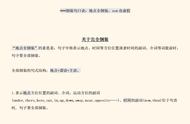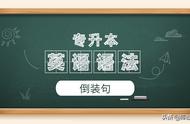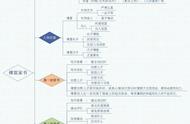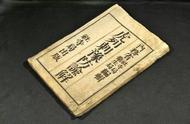疑问句和特殊疑问句要倒装
Are you cold?
Does he go to school by bike?
注意:若疑问词在句中作主语或主语的定语时,不倒装。
Who is your English teacher?
Whose father is a worker?
There be 句型
在There 助动词/情态动词 be 主语 地点/时间的句型中,主语在谓语be动词后面,因此这是倒装。
There is a mobile phone and some books on the desk.
桌上有一个手机和一些书。
There are thousands of people gathering on the square.
广场上聚集着成千上万的人
注意 :引导词there 还可以接appear,exist, lie, remain, seem, stand, live 等词。
There lived an old fisherman in the village.
村里住着一位老渔夫。
There stand two white houses by the river.
河滨矗立着两座白房子。
There existed some doubt among the students.
学生中有些怀疑。
直接引语在句首
“May I come in and take a rest?” asked the poor girl.
“Get out of the room!” shouted the angry woman.
虚拟条件句的倒装
当if引导的虚拟条件从句中含有had, were, should等时,如将if省略,则要将had, were, should等移到主语前,构成倒装句:
Had you come yesterday, you would have seen him.
若你昨天来,你就会见到他了。
Should you require anything give me a ring.
如果需要什么,可以给我打电话。
Were it not for your help, I would still behomeless.
要不是你帮助,我会仍然无家可归。
注意:省略if后提前的had不一定是助动词
Had I money, I would buy it. 假若我有钱,我就会买它。
全部倒装
全部倒装是只将句子中的谓语动词全部置于主语之前。
1)here, there, now,then, thus等副词置于句首, 谓语动词常用be,come, go, lie, run等表示来去或状态的动词。
例如:
Then came the chairman. 那时总裁来了。
Here is your letter. 你的信。
2)表示运动方向的副词或地点状语置于句首,以out, in, up, down, off, away等副词开头,谓语动词是表示“移动”的go, come, leave等句子里。
例如:
Ahead sat an old woman. 前面坐着一个老妪。
Down went the small boat. 小船沉下去了。
注意:在完全倒装的结构里,如果主语是人称代词,则用正常语序。
3)表示地点的介词词组位于句首,谓语动词是表示“存在”之意的be, lie, stand, exist等句子中。
South of the lake lies a big supermarket.
湖泊的南边是一个大超市。
20 miles east of our school lies a modernswimming pool.
我们学校向东20英里有一个现代化的游泳池。
4) 在there be或者there live(stand, appear, seem, remain, exist….) 句型中。
部分倒装
1.句首为否定或半否定的副词或连词。
如no, not,never, seldom, little, hardly, scarcely, rarely, at no time决不, by no means, on no account, inno case, many a time, under no circumstances, in no way, many a time, notuntil… 等。
例如:
He cares little about his clothes.
= Little does he care about his clothes.
他不在乎穿着。
I have never seen him before.
= Never have I seen him before.
= Never before have I seen him.
我以前没见过他。
The mother didn't leave the room until thechild fell asleep.
= Not until the child fell asleep did themother leave the room.
孩子睡着了,妈妈才离开房间。
(Not until引出的主从复合句中,主句倒装,从句不倒装。即:后倒前不倒。注意:如否定词不在句首不倒装。)
例如:
Churchill was not only a statesman, but apoet.
= Not only was Churchill a statesman, but apoet.
丘吉尔不仅是个政治家,而且还是个诗人。
I shall by no means give up.
= By no means shall I give up. 我决不放弃。
必背:表示“刚……就……的倒装结构
Hardlyhad he started to leave when itbegan to rain.
他刚要离开,天就下起了雨。
Scarcelyhad he sat down when his mobilephone rang.
他刚坐下,手机就响了。
No soonerhad he handed in his paper thanhe realized his mistakes.
他刚交卷就意识到出错了。
Seldomis my son late for school.我儿子上学几乎不迟到。
In no caseshould you touch it.无论如何你都不能碰它。
2.以否定连词开头作部分倒装
如 Not only…butalso, Hardly/Scarcely…when, No sooner… than等,前倒后不倒。例如:
Not only did he refuse the gift, he alsoseverely criticized the sender. 他没有收下礼物,还狠狠批评了送礼的人。
Hardly had she gone out when a student cameto visit her. 她刚出门,就有个学生来访。
No sooner had she gone out than a studentcame to visit her. 她刚出门,就有个学生来访。
3. so, neither, nor作部分倒装
表示另一主语“也…样”时,用“So be(have,助动词或情态动词) 主语”结构;而表示另一主语“也不…样”时,用“NorNeither be(have,助动词或情态动词) 主语”结构。
例如:
Tom can speak French. So can Jack. 汤姆会讲法语,杰克也会。
If you won't go, neither will I. 你不去,我也不去。
She won’t go. Neither/Nor will I.
她不走,我也不。
注意:如果前面所说的内容既有肯定又有否定,或前后的谓语动词形式不一致时,用“It is the same with 主语”结构或用“So it is with 主语”结构。
4.only 状语在句首倒装的情况。
only 副词;或介词短语;或状语从句时,主句倒装。
例如:
Only then did I see life was not easy.只有那时我才知道生活是不易的。
Only in this way, can you learn Englishwell. 只有这样,你才能学好英语。(only 介词短语)
Only after being asked three times did hecome to the meeting. 叫了三次,他才来参加会议。
Only yesterday did he find out that hiswatch was missing.(only 副词)
Only when it began to rain did he finishhis job.(only 状语从句)
注:如果句子为主从复合句,则主句倒装,从句不倒装。
例如:
Only when he is seriously ill does he everstay in bed. 病得狠重时,他才卧床休息。
5. so… that,such…that引导的结果状语从句中,部分倒装。当so位于句首时,用”so adj. 主语 谓语”。
例如:
So frightened was he that he did not dareto move an inch. 他害怕得很,动也不敢动。
So difficult was the exam that most of thestudents failed to pass it. 考试如此难,以至于大多数同学没能考过。
So stingy is she that none of us likes her.她太小气,没人喜欢她。
6. so作“也”讲时,引导的句子用倒装语序,表示前面所说的肯定情况也适用于另一人(或物)。其句型是:So be(have,助动词或情态动词) 主语
She has been to Tokyo. So have I.
她去过东京,我也去过。
He can send emails to his formerclassmates. So can she.
他能电子邮件给以前的同学,她也能。
7. as, though引导的部分倒装
as / though引导的让步从句由于语法需要,可将表语或状语提前(形容词, 副词, 分词, 实义动词提前)。
但需注意:
1)句首名词不能带任何冠词。
2)句首是实义动词, 其他助动词放在主语后。如果实义动词有宾语和状语,随实义动词一起放在主语之前。
例如:
Shortest as/though she is, she is not therichest.(倒装后,最高级前不用冠词)
Child as he is, he knows a lot.(倒装后,单数名词前不用a)
Fail as I did, I would try again.(倒装后,实义动词提前,在主语后添加助动词。)
注意:让步状语从句中,有though,although时,后面的主句不能有but,但是 though 和yet可连用。
当as作“虽然”解,引导让步状语从句时,必须将表语、状语或动词原形提到as前面。
句子的倒装语序有以下三种形式:
(1). 形容词或副词 as 主语 连系动词be或实义动词。
例如:
Rich as he is, he never spends a cent onclothes.
虽然他很富有,但他从不花一分钱在衣服上。
Much as I admire his courage, I don’t thinkhe acted wisely.
我虽然佩服他的勇气,但我认为他这样做是不聪明的。
(2). 名词 as 主语 连系动词be (注意句首的名词不带冠词)。
例如:
Child as he is, he knows a lot.
尽管他是个孩子,但懂很多事情。
Boy as he was, he was chosen king.
尽管他还是个孩子,但却被立为国王。
(3). 实义动词 as 主语 助动词[如果没有助动词,则要加上一个do(does或did)]。
例如:
Try as he may, he never succeeds.
尽管他很努力,但总是不成功。
Change your mind as you will, you will gainno additional support.
即使你改变主意,你也不会得到另外的支持。
8.一些表示频率的副词(如many a time, often等)位于句首时。
I have seen her taking a walk alone many atime.
Many a time have I seen her taking a walkalone.
我多次看到她独自一人在散步。
She often came to my house in the past.
Often did she come to my house in the past.
过去她常到我家来。
声明:本文来源网络,由高中英语(ID:gaozhong-yingyu)编辑整理,转载请注明出处。
























